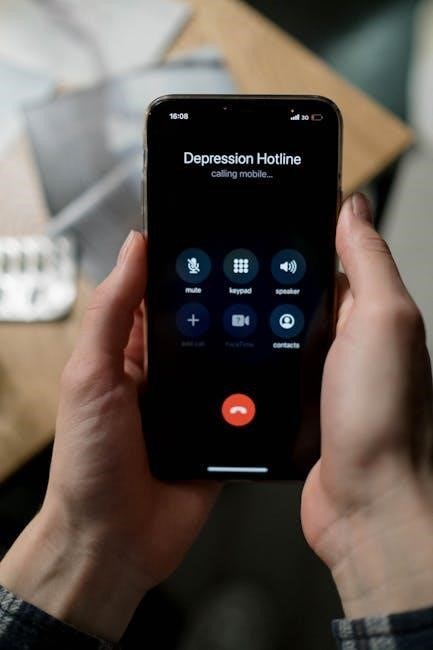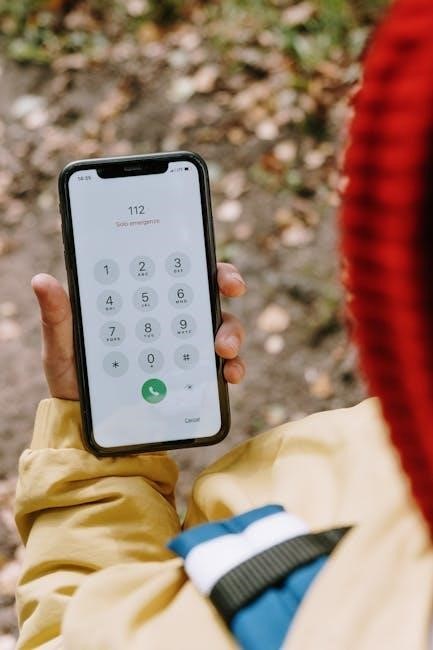
Emergency Contact Form PDF: A Comprehensive Guide
An emergency contact form PDF is a vital document. It captures crucial information for use during emergencies. Businesses, schools, and individuals use these forms. They ensure quick access to details in unforeseen circumstances. This guide offers examples, templates, and steps. It helps create efficient forms for various purposes. This prepares for medical emergencies.

What is an Emergency Contact Form?

An emergency contact form is a document used to collect details about individuals to notify in case of an accident, illness, or any situation needing immediate assistance. Schools, companies, healthcare providers, and various organizations use them. The form typically gathers names, phone numbers, and relationships of contacts. This allows prompt communication during crises. It’s a crucial tool for safety and well-being. Forms can exist as digital documents or physical papers. They ensure vital information is readily available. Keeping contact details updated is important. Regular reviews prevent outdated information. An emergency contact form plays a significant role. It allows efficient response to unexpected events. Accurate details are crucial. These forms are an essential component of emergency preparedness. Employers must ensure forms are completed; They can be customized for various purposes. Some include medical information. Secure storage is vital to protect privacy. It’s a proactive step for safety. A well-designed form can make a big difference. It aids in quick communication. It provides peace of mind. These forms are essential for everyone’s well-being.
Purpose of Emergency Contact Forms
The primary purpose of emergency contact forms is to provide crucial information that facilitates immediate communication and assistance during unforeseen events. They enable organizations and individuals to quickly reach designated contacts. This ensures that appropriate support and guidance are available when needed most. These forms are valuable in various settings. This includes schools, workplaces, and recreational facilities. They provide a structured way to gather and organize essential contact details. This includes names, phone numbers, and relationships to the individual. In emergencies, time is of the essence. This form allows quick access to relevant contact data. This enables swift notification of loved ones or responsible parties. This helps ensure appropriate care and support is provided. Emergency contact forms also serve to document medical information. This includes allergies, medications, and pre-existing conditions. This information helps in offering proper medical attention. Regularly updating forms ensures accuracy and reliability. This is especially important as contact information can change frequently. These forms help to promote safety and well-being. They ensure that individuals can get the help they need. They are a proactive step for risk management.
Who Uses Emergency Contact Forms?
Emergency contact forms are used across a wide spectrum of organizations and individuals. Schools and educational institutions use them to gather information about students. This information includes who to contact in case of illness or accidents. Employers rely on these forms to collect employee contact details. This allows them to notify family members in emergency situations. Healthcare providers use these forms to obtain patient contact information. This assists in contacting relatives during medical crises. Recreational organizations, such as sports clubs and summer camps, utilize these forms. This information is used to reach parents or guardians in case of emergencies involving participants. Landlords and property managers may request emergency contact information from tenants. This ensures they can reach someone if there are issues with the property. Individuals also use emergency contact forms for personal planning. This includes providing the information to caregivers or neighbors. This ensures someone knows who to contact in case of an emergency. Any organization or individual responsible for the well-being of others can benefit. Emergency contact forms offer a structured way to gather essential information. This can be readily accessed when needed most. This information promotes safety and preparedness in various settings.

Key Information Included in an Emergency Contact Form
An emergency contact form typically includes several essential pieces of information. The form gathers the full name of the individual for whom the contact information is being provided. It also requires the names of one or more emergency contacts. For each contact, the form collects their full name, phone number, and relationship to the individual. The form also includes primary phone numbers, including home, work, and mobile numbers. A current home address is also generally requested to provide location context. Some forms may also include an email address for each contact. This information provides an alternative means of communication. In some cases, medical information is requested. This information includes allergies, medications, and pre-existing conditions. This information helps emergency responders. The form may also ask for health insurance details, including the insurance company and policy number. This assists in facilitating medical treatment. Depending on the context, the form may also include a section for special instructions or considerations. This includes preferences or specific needs. Finally, the form typically includes a signature and date field. This confirms the accuracy and consent of the information provided. Some forms may also include a section for consent to transport the child to the nearest medical facility in emergency situations.
Emergency Contact Information
The core of any emergency contact form lies in the accuracy and completeness of its emergency contact information. This section is crucial for ensuring prompt and effective communication during a crisis. The form should clearly designate spaces for at least two emergency contacts. This provides redundancy in case the first contact is unreachable; For each contact, the form must capture their full legal name. This avoids confusion and ensures proper identification. The most important piece of information for each contact is their phone number. It is best practice to include fields for both mobile and home numbers. This increases the chances of reaching the contact quickly. The form should clearly state the contact’s relationship to the individual. This helps responders understand the contact’s role and level of authority. Furthermore, it is helpful to include the contact’s address. The address provides additional location information if needed. Finally, it is important to emphasize the need for up-to-date information. Contacts change jobs, phone numbers, and addresses. The form should be reviewed and updated regularly to reflect these changes. This ensures that the information remains accurate and reliable when it is needed most.
Medical Information (Optional)
While not always required, including a section for medical information on an emergency contact form can be incredibly beneficial in certain situations. This section provides first responders and medical personnel with vital details. This enables them to provide the best possible care during an emergency. If included, this section should be clearly marked as optional. This respects the individual’s right to privacy and choice; Key pieces of medical information to consider including are known allergies. Allergic reactions can be life-threatening, and knowing about them beforehand can save valuable time. Any existing medical conditions should also be listed. Conditions like diabetes, epilepsy, or heart conditions can significantly impact treatment. A list of current medications is crucial. Medications can interact with treatments or indicate underlying health issues. It is also beneficial to include information about the individual’s health insurance. Health insurance information ensures proper billing and facilitates access to care. Finally, any other relevant medical history should be noted. The medical history includes past surgeries or hospitalizations. Emphasize that the information provided is kept confidential. Only authorized personnel should access it during an emergency. Regularly updating this section is crucial to maintaining its accuracy and relevance.
Formats Available for Emergency Contact Forms
Emergency contact forms are available in various formats. The various formats cater to different needs and preferences. Choosing the right format ensures easy access, completion, and storage. Common formats include Word, PDF, Google Docs, and image files. Each format offers unique advantages and disadvantages. Word documents allow for easy editing and customization. Users can modify the form to suit specific requirements. PDF files ensure document integrity and consistent formatting across devices. They are ideal for printing and sharing without alteration. Google Docs provides collaborative editing capabilities and cloud storage. Google Docs is perfect for teams or organizations that need to share and update forms in real-time. Image files offer a simple visual representation of the form. The image files are suitable for quick viewing or embedding in other documents. The choice of format depends on factors like the need for editing, accessibility, and compatibility. Consider the intended use and the technical skills of the users. Select a format that best meets your needs. Many websites offer emergency contact form templates in multiple formats. This allows you to choose the one that best suits your requirements.
Word
Emergency contact forms in Word format offer significant flexibility. This flexibility is crucial for customization. Users can easily modify the template. Customization includes adding company logos, changing fields, and adjusting the layout. This adaptability makes Word a popular choice for organizations with specific needs. A Word document is easily editable. You can tailor it to reflect your brand and collect relevant information. Unlike PDFs, Word documents allow for dynamic content. Dynamic content can be implemented using features like drop-down menus and check boxes. This enhances user experience. It ensures accurate data entry. The ability to easily insert tables, images, and other elements makes Word a versatile tool. It can be used to create comprehensive and visually appealing forms. However, it is important to note that formatting may shift when opened on different devices. So, verify layout. Despite this potential issue, Word remains a practical option. It’s a practical option for creating and managing emergency contact forms, particularly when customization is a priority. The ease of use and widespread availability of Microsoft Word contribute to its popularity.

PDF (Portable Document Format) is a widely favored format. It is favored for distributing emergency contact forms. PDFs maintain formatting across different devices and operating systems. This ensures consistency. A PDF form guarantees that the layout and content appear as intended, regardless of the user’s setup. PDF forms can be created as fillable forms. Fillable forms allow users to directly input information. This eliminates the need for printing and manual completion. Fillable PDF forms streamline the data collection process. They reduce the risk of errors. Security features can be added to PDF forms. Security features include password protection and restrictions on editing or printing. These features ensure that sensitive information remains confidential. PDF is an excellent choice. It’s excellent for organizations prioritizing data security and consistent presentation. While direct editing of a PDF requires specialized software, free viewers are readily available. This makes it accessible to a broad audience. PDF forms can be easily integrated into websites or email communications. This simplifies distribution. PDF forms offer a balance of security, accessibility, and visual consistency. This makes them a reliable option. They are a reliable option for managing emergency contact information efficiently and securely. The format is ubiquitous.
Google Docs
Google Docs presents a collaborative and accessible avenue. It’s an avenue for creating and managing emergency contact forms. As a web-based word processor, Google Docs enables real-time collaboration among multiple users. This feature is invaluable for teams that need to contribute to or review the form’s content simultaneously. Changes are automatically saved. This eliminates concerns about data loss. Google Docs is accessible from any device with an internet connection. It enhances flexibility. This is especially useful for remote teams or individuals on the move. Sharing a Google Doc is straightforward. It allows for easy distribution to employees, students, or other relevant parties. Access permissions can be customized. This allows control over who can view, comment, or edit the document. Google Docs integrates seamlessly with other Google services. Google Forms can be used to collect the data. The data is then automatically populated into a Google Sheet or Doc. This streamlines data management. While Google Docs requires an internet connection for real-time collaboration, offline access is also available. It ensures continued productivity. Google Docs provides a version history feature. This allows users to track changes and revert to previous versions if needed. Google Docs is a cost-effective solution. It’s cost-effective for organizations already utilizing the Google Workspace suite. It’s a versatile and user-friendly platform. It’s versatile for handling emergency contact information.
Image
The image format offers a straightforward approach. It is a straightforward approach to using emergency contact forms. An image file, such as a PNG or JPG, presents a static representation of the form. This format is ideal for situations. It is ideal where quick viewing or printing is the primary need. Image files are universally compatible. They can be opened on virtually any device without requiring specific software. This ensures accessibility for everyone; While image files are easy to view, they are not directly editable. This can be an advantage. It can be an advantage when preserving the form’s original layout. To fill out an image-based form, you would typically print it. Then, manually complete it with a pen. Alternatively, image editing software can add text fields. Image-based templates are suitable for distribution via email or websites. They can be easily embedded into other documents. Consider using a high-resolution image to maintain clarity. This is especially important when printing the form. An image with a transparent background can be useful. It can be useful for incorporating the form into letterheads. It’s a simple way to create and share forms. It is a simple way when advanced editing is not necessary. It provides a convenient and universally accessible solution.
Where to Find Emergency Contact Form Templates
Locating emergency contact form templates is easier than ever, thanks to the vast resources available online. Numerous websites offer free and premium templates for various needs. Consider starting with reputable office supply websites. They often provide a selection of templates compatible with different software. Many human resources websites provide emergency contact form templates. These are tailored for employee use. Look for templates available in multiple formats, such as Word, PDF, and Google Docs. This ensures compatibility with your preferred software. Online form builders often include emergency contact form templates. These platforms often allow for customization and easy distribution. Government websites may offer templates specific to certain industries or regulations. These are often related to childcare or healthcare. Search for templates tailored to your specific needs. Consider the purpose of the form and the information you need to collect. Ensure that the template includes all necessary fields, such as contact information and medical details. Remember to review the template carefully. Check for accuracy and compliance with relevant privacy laws; Download templates from trusted sources to avoid potential security risks. With a little research, you can find the perfect emergency contact form template to meet your needs and ensure you’re prepared for any situation. This will provide peace of mind.
Importance of Regularly Updating Emergency Contact Forms
Regularly updating emergency contact forms is paramount for safety and preparedness. Life circumstances change, and contact information can become outdated quickly. People move, change phone numbers, or alter their relationships. These changes render the information on file inaccurate and useless in an emergency. Imagine a scenario where you need to reach someone listed as an emergency contact, only to find the number disconnected or the person no longer associated with the individual. This delay can have serious consequences, especially in medical emergencies. Therefore, establishing a system for periodic updates is essential. Employers should request employees to review and update their forms annually or whenever significant life changes occur. Schools should send reminders to parents at the beginning of each academic year. Individuals should proactively update their personal emergency contact forms after moving. A simple review process ensures that the information remains current and reliable. This process includes verifying phone numbers, addresses, and relationships. It also entails confirming that the listed contacts are still willing and able to act as emergency contacts. By prioritizing regular updates, you ensure that emergency responders can quickly reach the right people. This can provide critical assistance when it matters most. This can improve response times and outcomes in critical situations.